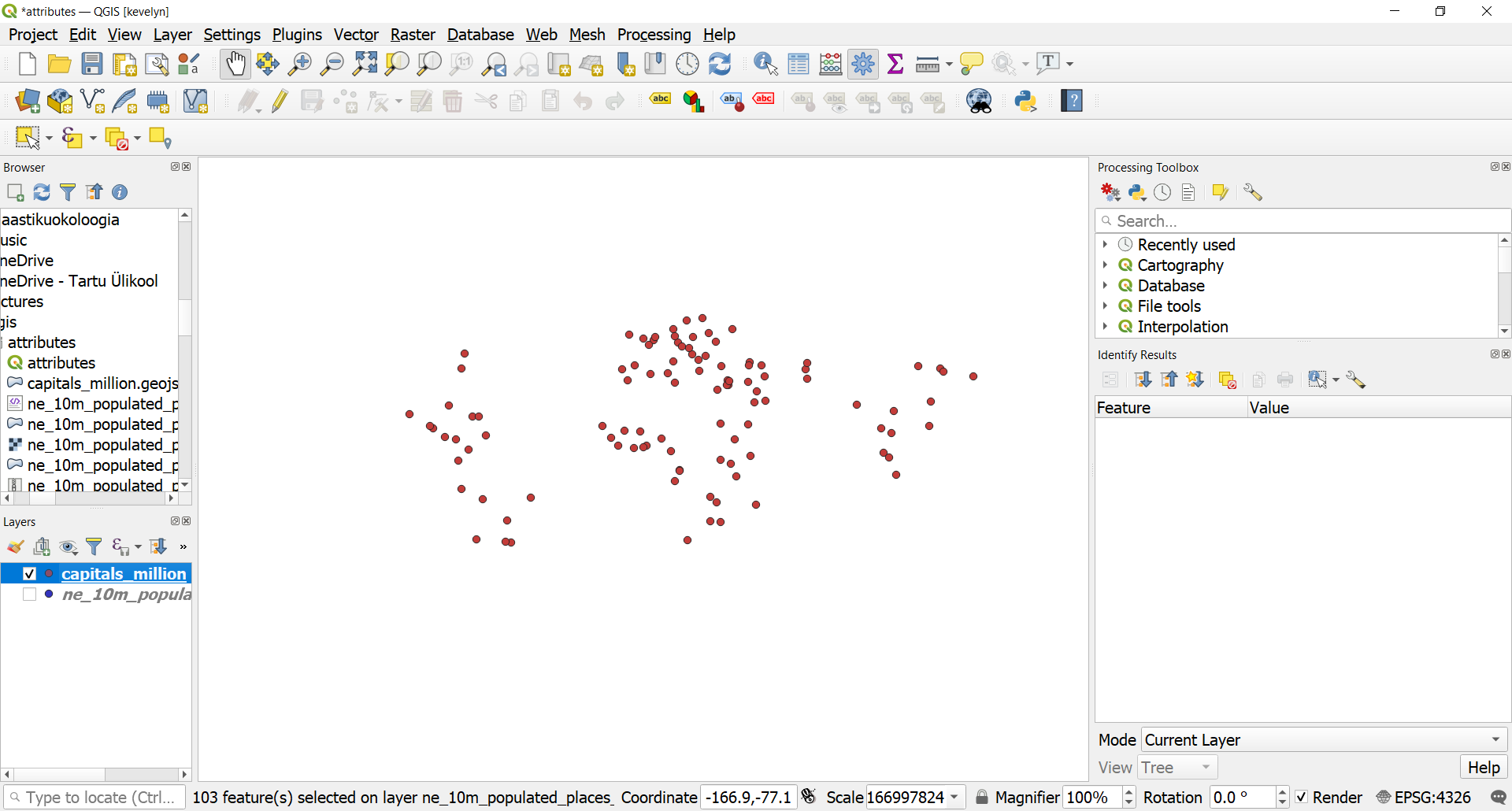GIS data has two parts - features and attributes. Attributes are structured data about each feature. This tutorial shows how to view the attributes of a GIS vector layer and do basic queries on them in QGIS. The tutorial is mainly based on Ujaval Gandhi’s QGIS Tutorials and Tips.
The tutorial consists of the following steps:
1. Download data
Natural Earth provides a Populated Places dataset. Download the simple (less columns) dataset. Extract the dataset to your working folder.
For convenience, you may directly download a copy of datasets from the link below: ne_10m_populated_places_simple.zip
Data Source: Natural Earth
2. Steps to work with attributes
2.1. Identifying single objects on the map
- Locate the ne_10m_populated_places_simple.shp file in the QGIS Browser drag it to the map view. Save your project with a suitable name to your working folder.
Tip

You can also add files directly from zip-file without extracting them if you expand the zip file in the Browser and drag the shp-file to the map view.
- A new ne_10m_populated_places_simple will now be loaded in QGIS and you will see many points representing the populated places of the world. The default view in the QGIS canvas shows the geometry of the GIS layer. Each point also has associated attributes. Let’s view them. Locate the Attributes Toolbar. This toolbar contains many useful tools to inspect, view, select, and modify the attributes of a layer. If you do not see the toolbar, you can enable it from
View ► Toolbars ► Attributes Toolbar.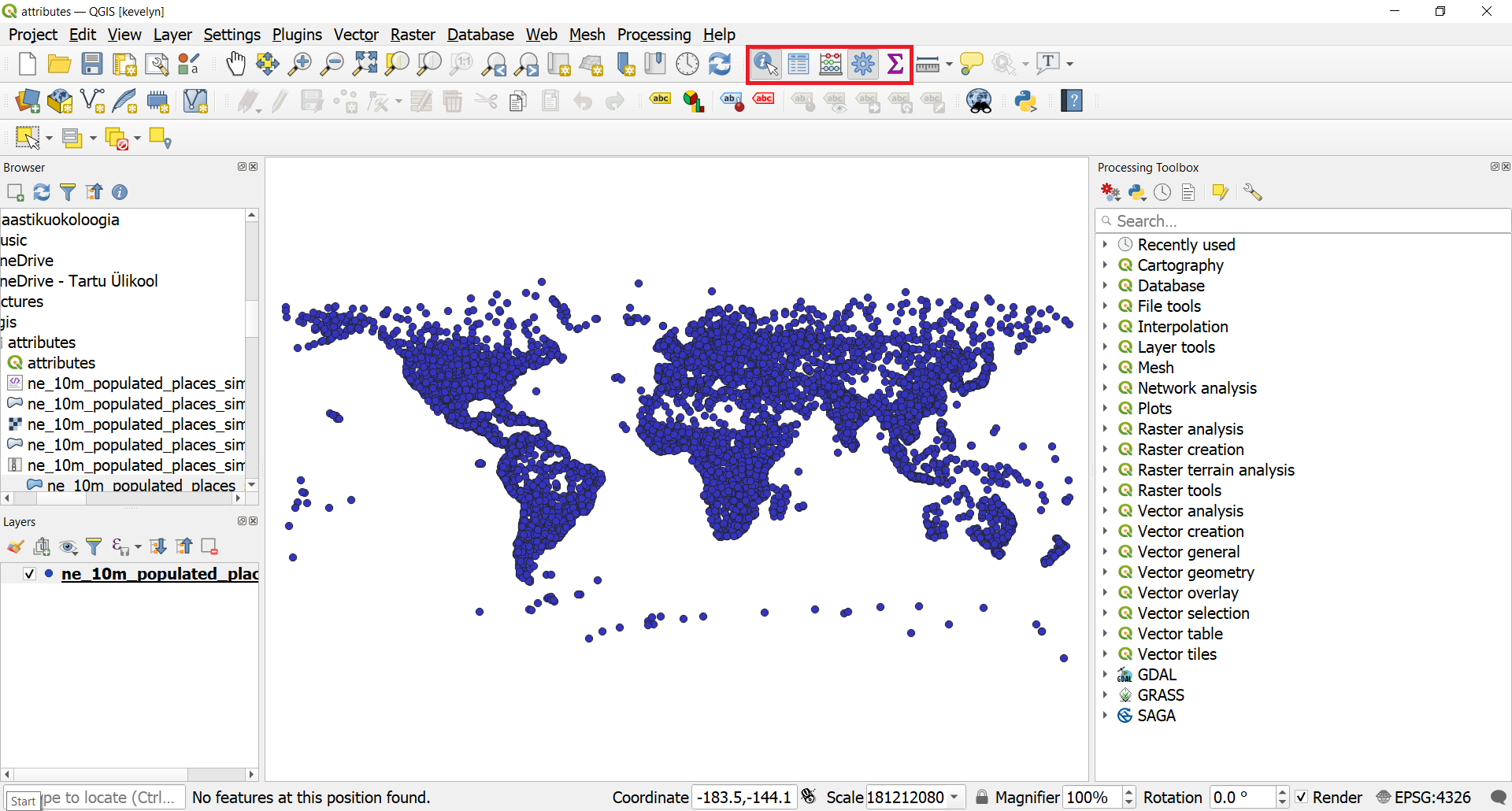
- Click the Identify button
 on the Attributes Toolbar. Once the tool is selected, click on any point on the canvas. The associated attributes of that point will be displayed in a new Identify Results panel. Once you are done exploring attributes of different points, you can click the Close button.
on the Attributes Toolbar. Once the tool is selected, click on any point on the canvas. The associated attributes of that point will be displayed in a new Identify Results panel. Once you are done exploring attributes of different points, you can click the Close button.
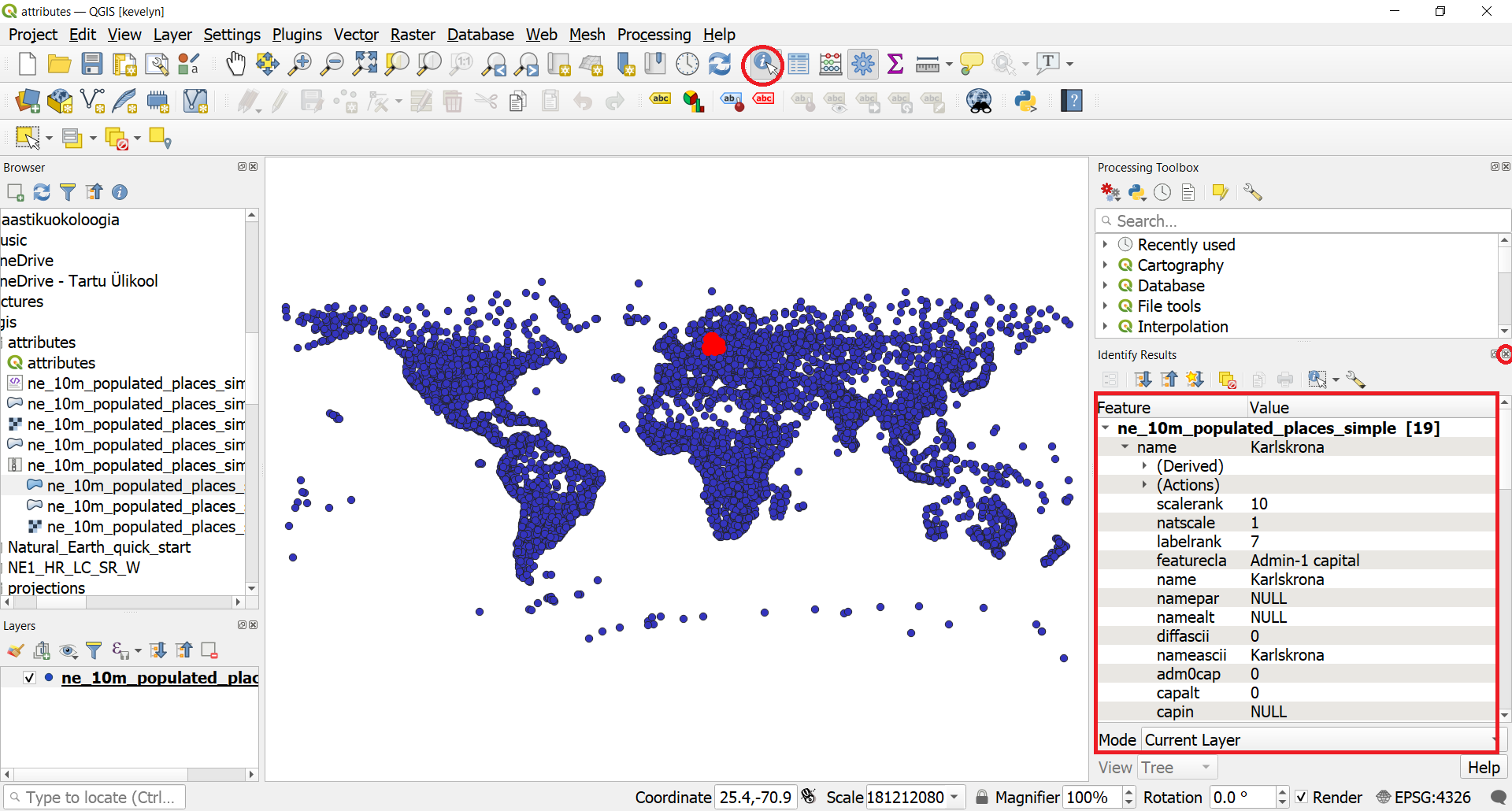
- You can also view all of the attributes together as a table. Click the Open Attribute Table button
 on the Attributes Toolbar. You can also right-click the ne_10m_populated_places_simple and select Open Attribute Table.
on the Attributes Toolbar. You can also right-click the ne_10m_populated_places_simple and select Open Attribute Table.
Tip

You can also open the attribute table with F6 from the keyboard. However, the layer of which attribute table you wish to open must be selected from the Layer panel.
- In the attribute table, scroll horizontally and locate the pop_max column. This field contains the population of the associated place. You can click on the field header to sort the column in ascending order. You can see that two cities have values of -99 which obviously can’t be a population value. Value -99 indicates here No Data meaning that there is no data about the population of these places.
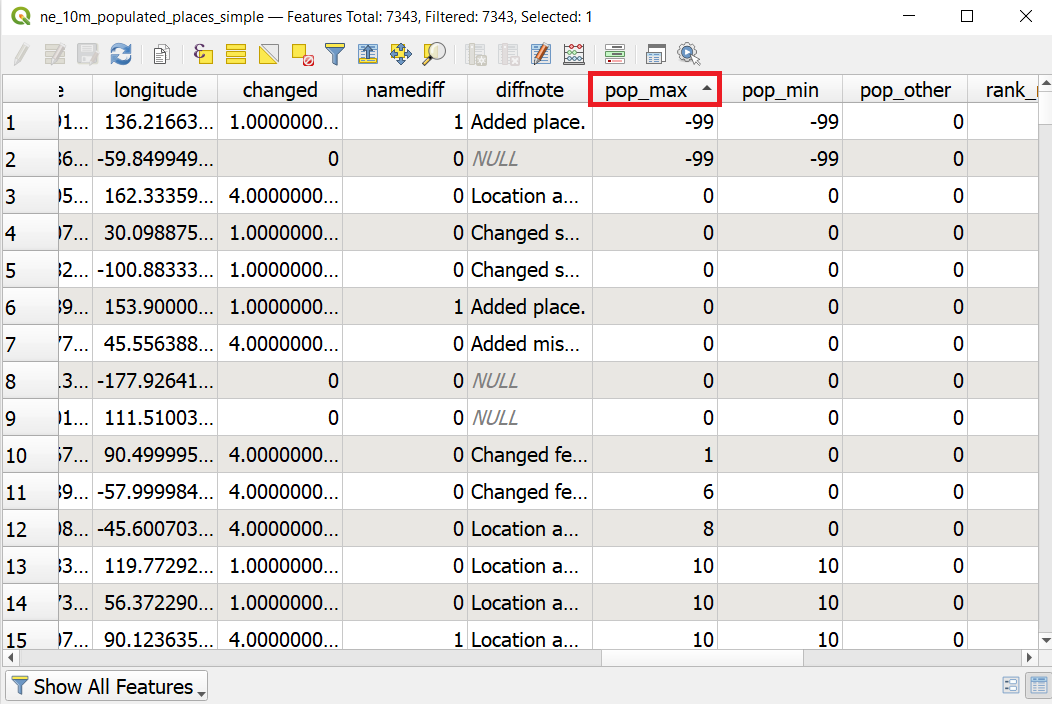
- Click again on the field header to sort the column in descending order this time. The highest value is over 3.5 million and if you scroll horizontally to the left and find the field name then you can see that the city is Tokyo. Click on this first row to make it selected (goes blue). You can now see on the map where the selected point (currently Tokyo) is located if you click on the Zoom map to the selected rows button
 from the attribute table toolbar and go to your Map view. You should now see the zoomed in view to Tokyo and Tokyo is colored yellow. Yellow is usually always marking the color of selected objects in GIS-programs.
from the attribute table toolbar and go to your Map view. You should now see the zoomed in view to Tokyo and Tokyo is colored yellow. Yellow is usually always marking the color of selected objects in GIS-programs.
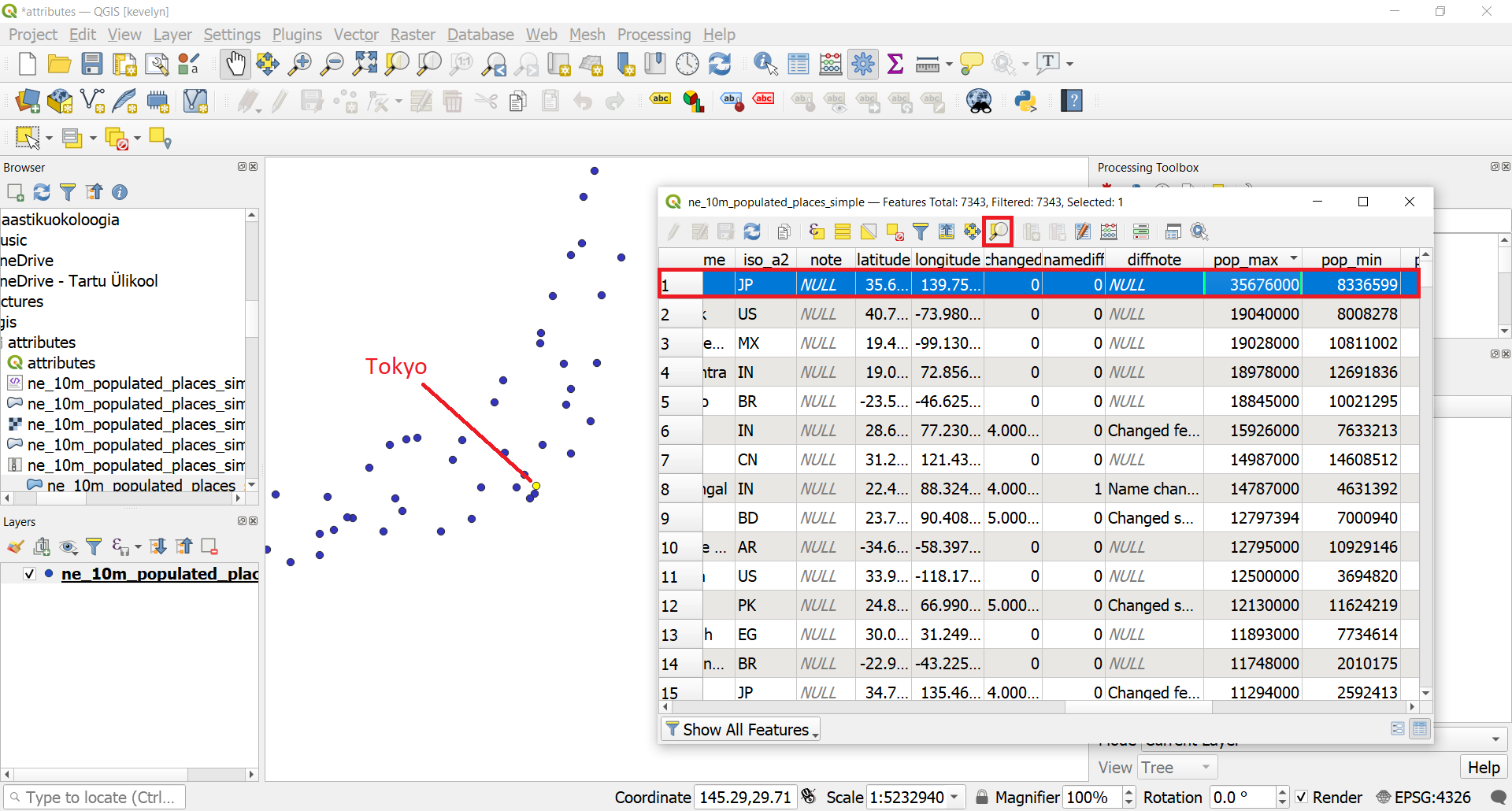
Tip

You change the default selection color under
Settings ► Options... ► Canvas&Legendand Selection color.
2.2. Making queries with expressions
- Lets perform our query on these attributes. QGIS uses SQL-like expressions to perform queries. Click Select features using an expression button
 from the attribute table toolbar. In the Select By Expression window, expand the Fields and Values section and double-click the pop_max label. You will notice that it is added to the expression section at the bottom. If you aren’t sure about the field values, you can click the All Unique button to see what the attribute values are present in the dataset. For this exercise, we are looking to find all features that have a population greater than 1 million. So complete the expression as below and click Select Features and then Close.
from the attribute table toolbar. In the Select By Expression window, expand the Fields and Values section and double-click the pop_max label. You will notice that it is added to the expression section at the bottom. If you aren’t sure about the field values, you can click the All Unique button to see what the attribute values are present in the dataset. For this exercise, we are looking to find all features that have a population greater than 1 million. So complete the expression as below and click Select Features and then Close.
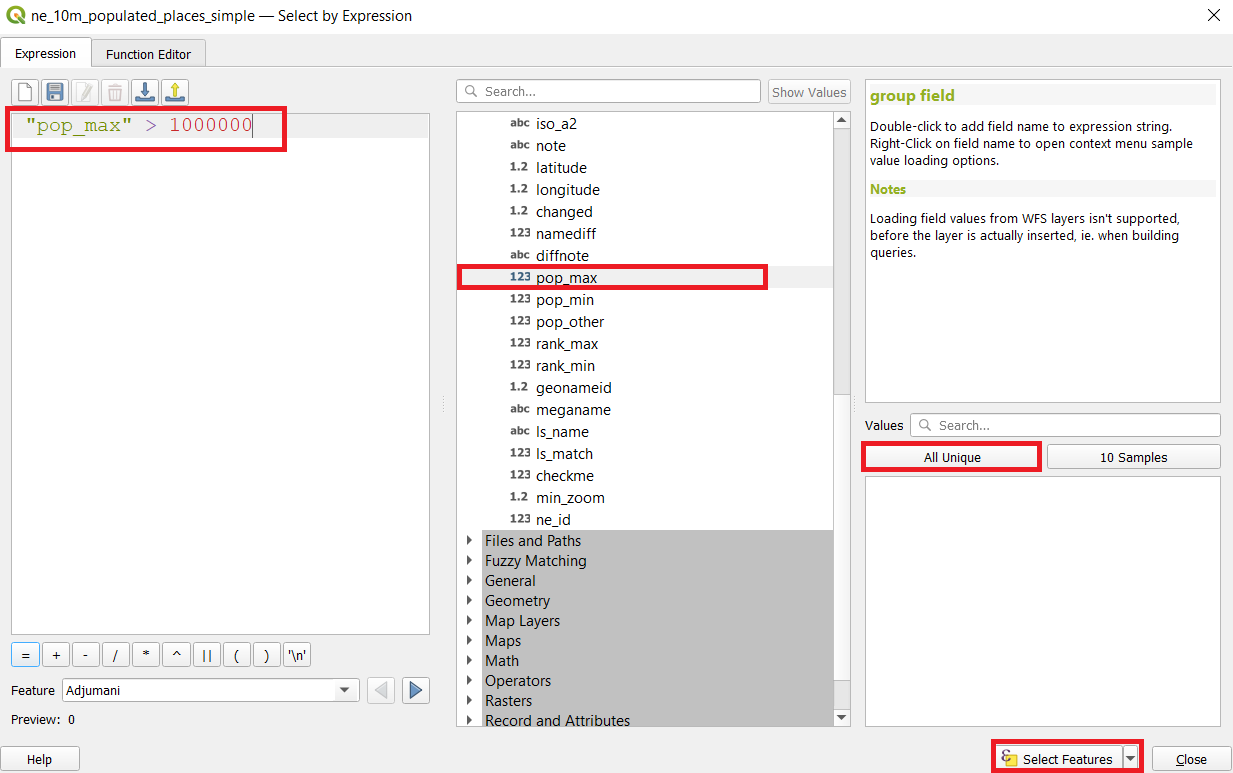
 Note
NoteIn the QGIS Expression engine, text with double-quotes refers to a field and text with single-quotes refers to a string value. For example, if you would want to find Tokyo from the attribute table by using expression then your expression would look like this “name” = ‘Tokyo’.
- You will notice that more rows in the attribute table are now selected. The label window also changes and shows the count of selected features. Close the attribute table window and return to the main QGIS window. You will notice that a subset of points is now rendered in yellow. This is the result of our query and the selected points are the ones having pop_max attribute value greater than one million.

- Let’s update our query to include a condition that the place should also be a capital in addition to having a population greater than 1 million. To quickly get to the expression editor, you can use the Select Features by Expression
 button in the toolbar.
button in the toolbar.
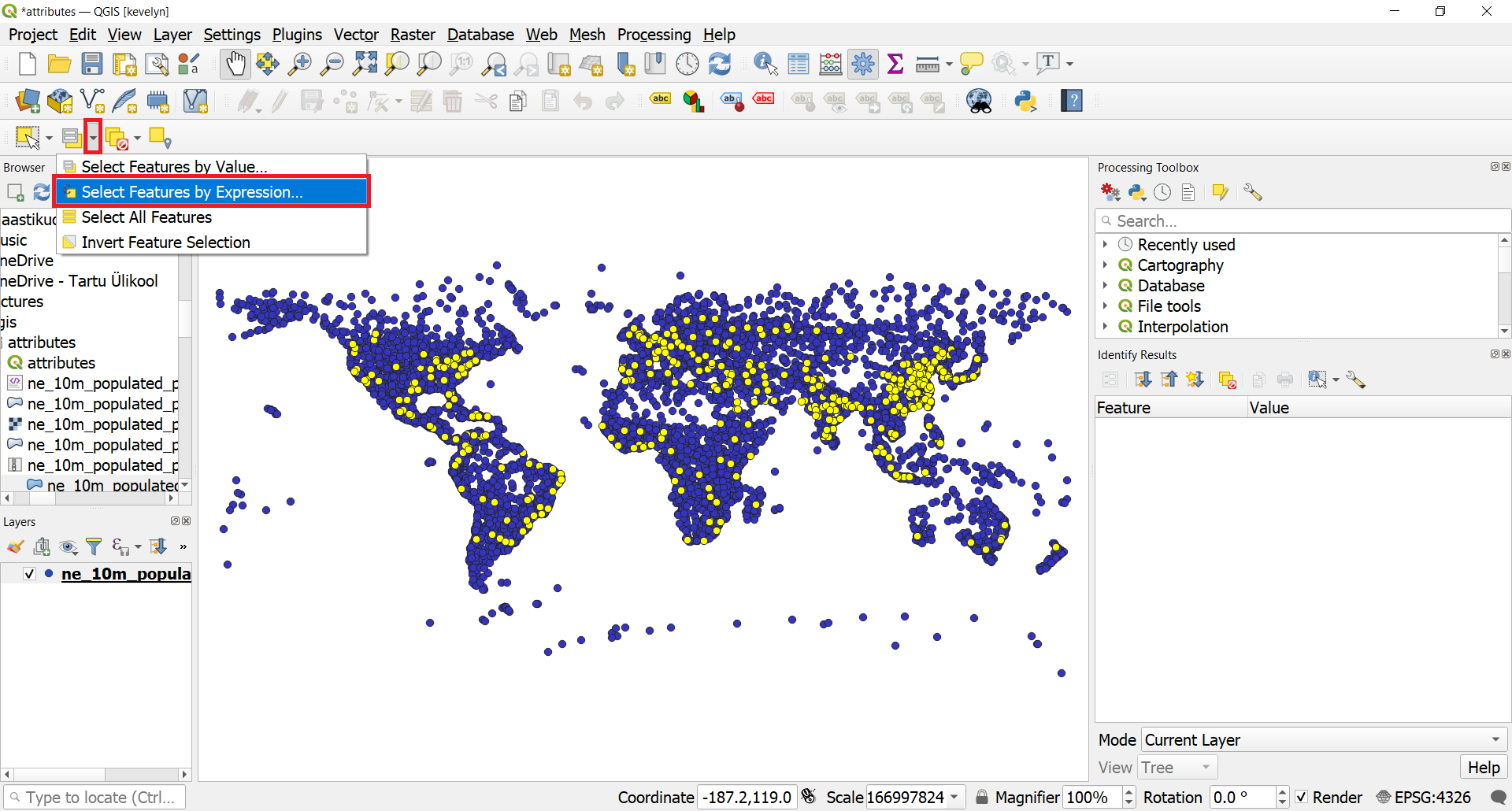
- The field containing data about capitals is adm0cap. The value 1 indicates that the place is a capital and value 0 that it is not a capital. We can add this criteria to our previous expression using the and operator. Enter the expression as below and click Select Features and then Close.
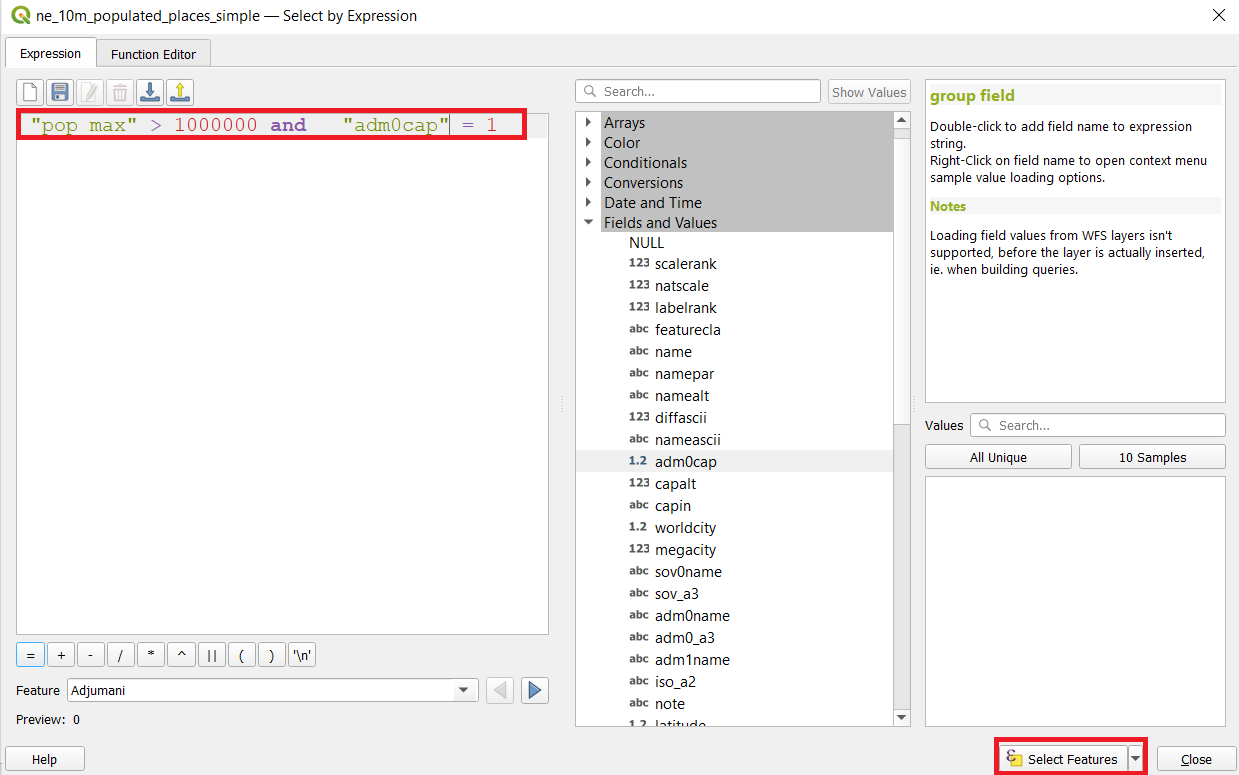
- Look to the Map view. Now you will see a smaller subset of the points selected. This is the result of the second query and shows all places from the dataset that are country capitals as well as have population greater than 1 million.
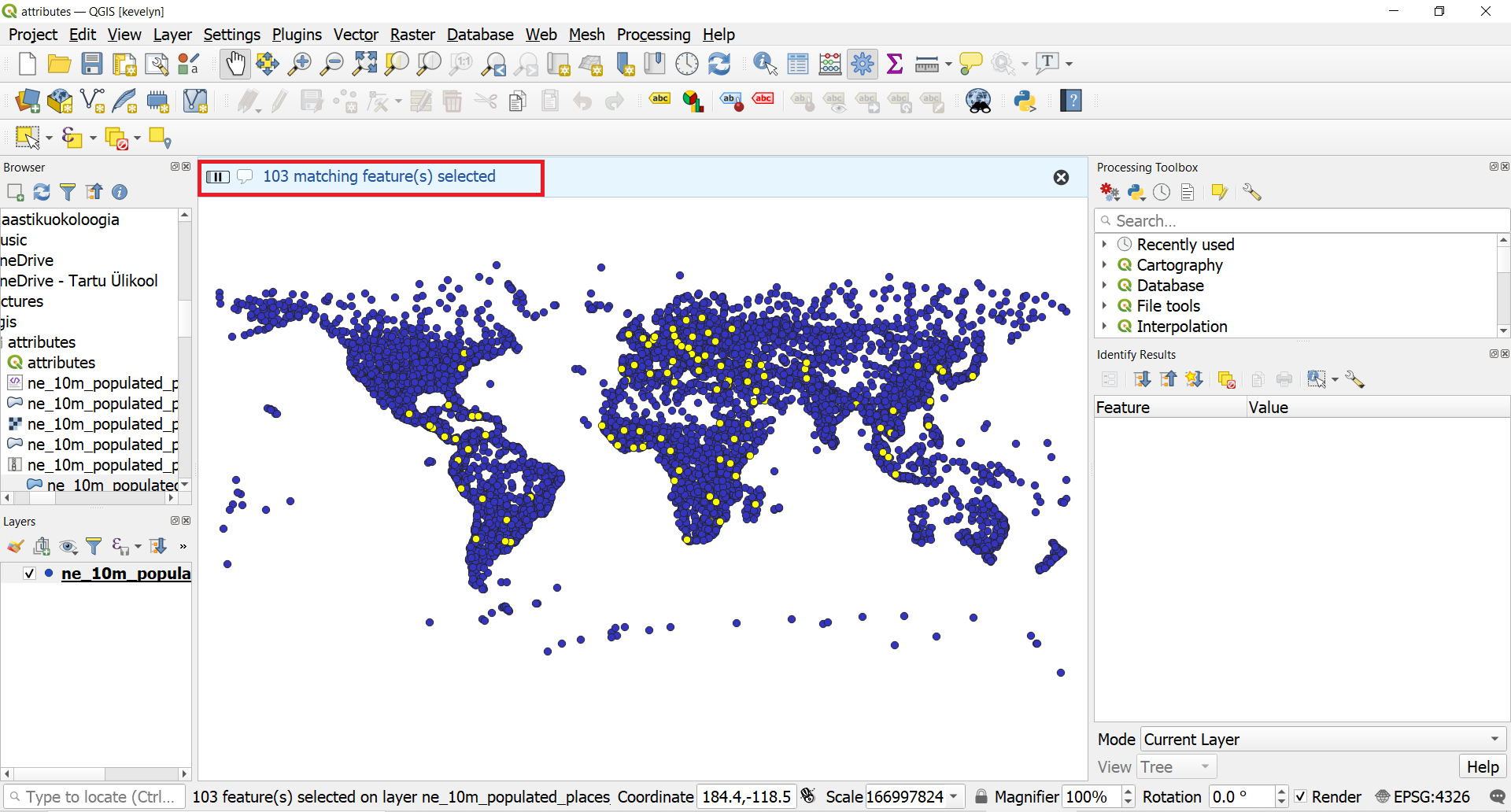
2.3. Exporting the selection as file
- Now we will export the selected features as a new layer. Right-click the ne_10m_populated_places_simple layer and go to Export ‣ Save Selected Features As… QGIS can export many formats, including GeoPackage, ESRI shp etc. For this exercise, we will choose GeoJSON. GeoJSON is a open text-based format that is used widely in web mapping. Click the … button next to File name and enter capitals_million.geojson as the output file. The input data has many columns. You are able to choose only a subset of the original columns for export. Expand the Select fields to export and their export options section. Click Deselect All and check the name and pop_max columns. Click OK.
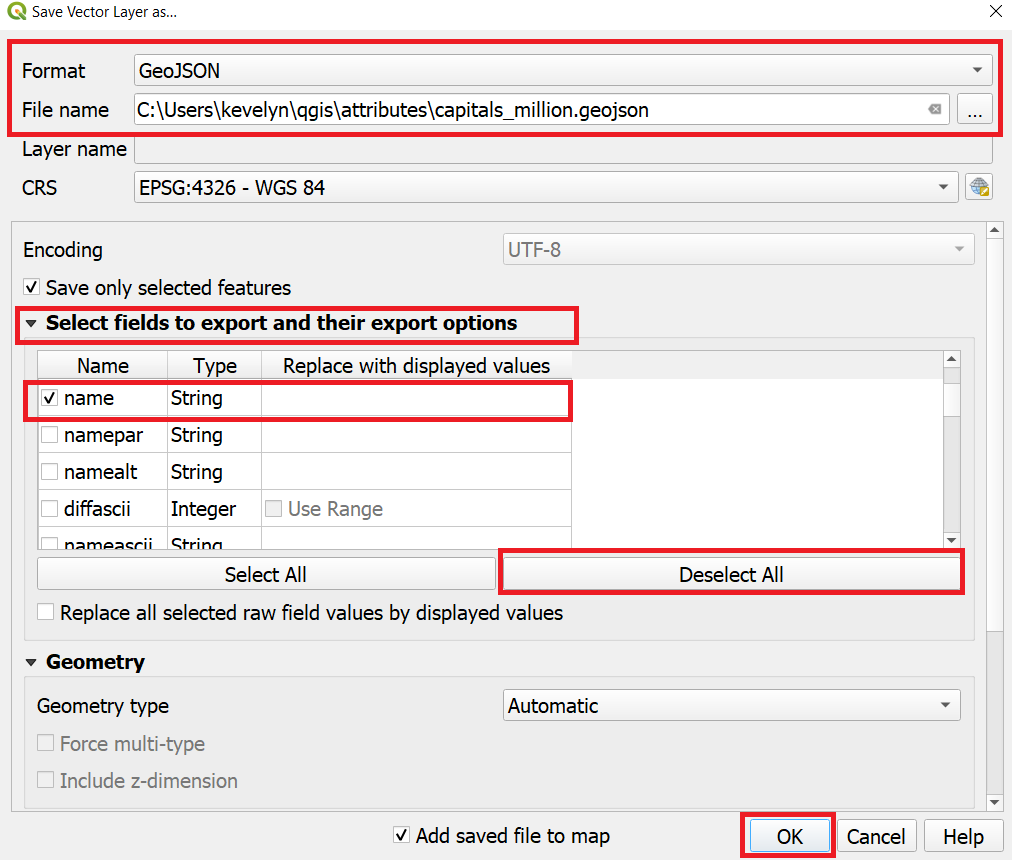
- A new layer capitals_million will be loaded in QGIS. You can un-check the ne_10m_populated_places_simple layer to hide it and view the points from the newly exported layer.
